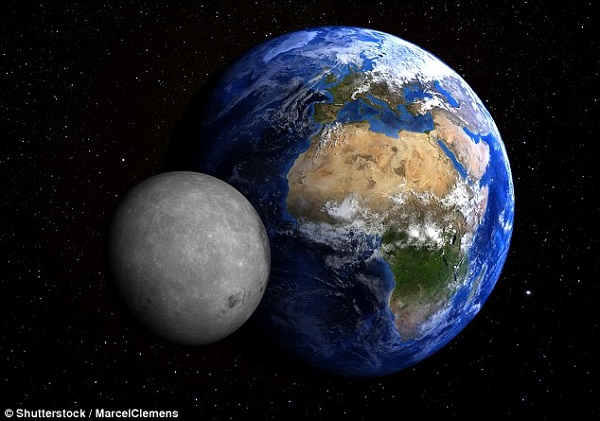The moon is currently spinning away from Earth at a rate of around 3.8 centimetres a year.
But experts believe that in the future this could change, and the two bodies could one day be on a collision course.
If the moon and Earth collide, the energy released in the merging would melt the Earth into a magma ocean.
Thankfully, the catastrophic event is not forecast to occur for some 65 billion years.
The prediction comes from Dr Jason Barnes, a planetary scientist.
Dr Barnes said: ‘The final end-state of tidal evolution in the Earth-moon system will indeed be the inspiral of the moon and its subsequent collision and accretion onto Earth.’
The moon first formed around 4.5 billion years ago, and has been slowly moving away from Earth ever since.
This recession is mainly due to the action of the Earth’s tides.
The moon is kept in orbit by Earth’s gravitational force, but at the same time, the moon also exerts a gravitational force on our planet, which causes the movement of the Earth’s oceans, to form a tidal bulge.
As the Earth rotates, this tidal bulge sits slightly ahead of the moon, and feeds a small amount of energy into the moon, pushing it into a higher orbit.
You can picture this as being like the faster outside lanes of a racing track.
To understand the rate of recession of the moon, researchers can bounce lasers onto reflectors that were left on the moon
Dr Barnes said: ‘We bounce lasers off of these and other retro reflectors on the Lunokhod rovers to measure the distance to the moon precisely.
‘Using these, we’ve directly measured how fast the moon is receding.’
But Dr Barnes suggests that the Earth’s rotation will one day slow down, until it is the same as the moon’s orbital period.
At that point the moon will stop moving outwards.
Meanwhile, in six billion years, the sun is expected to go through a ‘Red Giant phase’, when it runs out of nuclear fuel, and its core becomes a burned-out remnant white dwarf.
The outer layers of the sun will then expand outwards beyond Earth’s orbit, sapping energy from the Earth-moon system.
This would cause the moon to start creeping towards the Earth.
Dr Barnes said: ‘Eventually, it would get so close that it would spiral inward, dissipating its orbital kinetic energy in a spectacular collision and merger with the Earth,’ said Barnes.
With the sun having been a white dwarf for tens of billions of years, the Earth would be frozen solid.
But if the moon and Earth collide, this could be set to change.
Dr Barnes added: ‘The energy released in the merging would re-melt the Earth into a magma ocean. According to daily mail.
N.H.Kh

